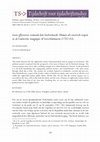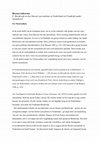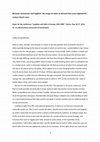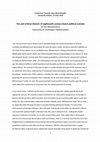Papers by Ivo Nieuwenhuis
This article discusses the late eighteenth-century Dutch periodical 'Lanterne Magique of Toverlan... more This article discusses the late eighteenth-century Dutch periodical 'Lanterne Magique of Toverlantaern'. This political journal is analyzed from the perspective of its sense of humor and its rhetoric. 'Lanterne Magique', it is shown, is all about humiliating and scapegoating political enemies, and schadenfreude is the main means through which this is done. Political opponents are jocularly depicted as drunkards, cowards and perverts. Thus, schadenfreude, as part of a broader culture of defamation, turns out to be a useful tool within late eighteenth-century public debate. Furthermore, the seeming popularity of 'Lanterne Magique' tells us that both this debate and the sense of humor of eighteenth-century society differ from that of our own day. Realizing this will make us better understand early-modern political rhetoric and laughter.

Performing rebelliousness: Dutch political humor in the 1780s
This article takes the notion of rebelliousness as the starting point for an analysis of eighteen... more This article takes the notion of rebelliousness as the starting point for an analysis of eighteenth-century Dutch political humor. In several recent publications from humor scholars, the rebellious image of political humor in today’s world is questioned. This skepticism towards the idea of humor as a form of rebellion is connected to four sources of political humor that were published as part of the conflict between the reformist Patriots and the conservative Orangists, that took place in the Dutch Republic during the 1780s. It is shown that, comparable to the situation in contemporary political humor, the rebellious outlook of these sources is to a large extent a matter of rhetoric and convention. Their crossing of social and cultural boundaries and their attacks on the powers that be are part of a long cultural tradition, of which the actual social impact is doubtful. Also, the humor used in these sources contains obvious disciplinary tendencies, that emasculate their rebellious potential in yet another way. The new insights regarding political humor of the past that are thus produced prove the scholarly relevance of connecting theoretical perspectives based on the study of contemporary humor to historical cases of humor.
Politiek op de kermis. Het genre van de gefingeerde rarekiekvertoning.
This article discusses the genre of fake peepshows, 17th- and 18th-century pamphlets that imitate... more This article discusses the genre of fake peepshows, 17th- and 18th-century pamphlets that imitate the performance of a peepshow, and in doing so give a comic account of current affairs.
Enlightenment Subverted
Topics in Humor Research, 2015
This article argues that the common satirical technique of parody does not only mock the formal q... more This article argues that the common satirical technique of parody does not only mock the formal qualities of genres and media, but also functions as a tool for social criticism. This view is illustrated by means of a Dutch satirical case from the late eighteenth century, the almanac-like periodical De Lantaarn
(1792–1801) by Pieter van Woensel. It is shown that De Lantaarn’s parody of the almanac, a genre that had strong educational and ‘Enlightening’ connotations at the time, can be interpreted as a critique on contemporary (ab)uses of the
Enlightenment discourse. This ‘social criticism through parody’ is what makes satires like De Lantaarn subversive.

This article discusses the late eighteenth-century Dutch periodical Lanterne magique of toverlant... more This article discusses the late eighteenth-century Dutch periodical Lanterne magique of toverlantaern. This political journal is analyzed from the perspective of its sense of humor and its rhetorical strategy. The Lanterne magique turns out to offer a striking example of so-called defamatory rhetoric. In this periodical it is all about humiliating and scapegoating political enemies, and Schadenfreude is the main means through which this is done. The enemies are jocularly depicted as drunkards, cowards and perverts. Thus Schadenfreude, as part of the broader culture of slanderous attack, turns out to be an effective tool within late eighteenth-century public debate. Besides that, the fact that the Lanterne magique was so successful at the time, tells us that both this debate and the sense of humor of eighteenth-century Dutch society differ from that of our own time. Realizing this, we can start to understand early-modern political rhetoric and laughter better.
Spiegel der Letteren, 2013
Publiek, ik veracht u...enigszins. Discursieve autonomie in Nederland rond 1800
relativerende satire Ivo Nieuwenhuis This article discusses Pieter van Woensel's Lantaarn (1792-1... more relativerende satire Ivo Nieuwenhuis This article discusses Pieter van Woensel's Lantaarn (1792-1801), a satirical Dutch illustrated

ivonieuwenhuis.nl
In de eerste helft van de twintigste eeuw was er in het culturele veld sprake van een ware explos... more In de eerste helft van de twintigste eeuw was er in het culturele veld sprake van een ware explosie aan -ismes. Een daarvan was het surrealisme. Deze stroming manifesteerde zich op verschillende manieren. Zo was er in Frankrijk een groep schrijvers onder leiding van André Breton die zich surrealistisch noemde. Deze schrijvers waren avant-gardistisch en toonden een grote politieke betrokkenheid. (Van Buuren 1996, p. 135-138) Naast deze groep bestond er ook een variant van het surrealisme die zich veel autonomer opstelde. Deze keerde zich juist af van de werkelijkheid en richtte zich vooral op de vorm. Een goed voorbeeld van een schrijver bij wie deze vorm van surrealisme gestalte kreeg, is Franz Kafka. In dit artikel maakt Ivo Nieuwenhuis een vergelijking tussen deze twee varianten van het literair surrealisme. In Nederland heeft het surrealisme eigenlijk alleen invloed gehad in de schilderkunst: J. Moesman, Pyke Koch en Carel Willink (…) De literaire en filosofische ideeën waren voor Nederland te wild. (…) Misschien is de invloed van het surrealisme langs indirecte weg doorgedrongen in het werk van Hendrik de Vries, Gerrit Achterberg en enkele Vijftigers, maar de Nederlandse schrijvers hebben het surrealisme nooit echt omarmd. (Van Buuren 1996, p. 152) Als Van Buuren in het boek Moderne Franse literatuur van 1850 tot heden spreekt over het surrealisme, doelt hij op de Franse variant. Hij verliest echter uit het oog dat er nog variant bestaat: de autonome. En die variant vinden we wel degelijk terug in de Nederlandse literatuur, met name bij Ferdinand Bordewijk. Het onderstaande behelst een inventarisatie van de ideeën van Bordewijk -gezien als een vertegenwoordiger van het literair surrealisme in Nederland -gevolgd door een bespreking van een van zijn surrealistische verhalen. Daarna zal ik de Franse surrealisten kort behandelen, om te vervolgen met een vergelijking tussen deze groep en Bordewijk. Het doel is om aan te tonen dat beide varianten, naast alle verschillen, ook enkele belangrijke overeenkomsten delen en dat het dus onjuist is om te zeggen dat het literair surrealisme in Nederland niet heeft bestaan. Als theoretisch kader fungeren de ideeën van Sigmund Freud, Buuren 1993, p. 10-11) Het zijn deze principes die de literaire surrealisten veelvuldig gebruikten. Daarmee is uiteraard nog niets gezegd over de exacte invulling ervan. De theorie van Freud was en is voor vele interpretaties vatbaar. Ook werden zijn ideeën door talloze mensen bekritiseerd. Zo meende bijvoorbeeld Jacques Lacan, Freuds belangrijkste navolger en criticus, dat het onbewuste juist wel talig was. (Van Buuren 1993, p. 14) Binnen de literatuur zorgde de ambiguïteit van Freuds theorie ervoor dat er verschillende varianten van het surrealisme konden ontstaan. In alle gevallen was echter het model van de menselijke geest, zoals dat door Freud was bedacht, met zijn bewuste en onbewuste laag, de basis. Daarmee is Freud een onmisbare figuur voor het ontstaan en de ontwikkeling van het surrealisme.
Conference Presentations by Ivo Nieuwenhuis

Satires offer themselves to the audience in all kinds of forms: from novels to pamphlets, from ca... more Satires offer themselves to the audience in all kinds of forms: from novels to pamphlets, from cartoons to ritual performances, from learned wit to slanderous attacks. This was as much the case in early modern Europe as it is in contemporary (Western) society. Still, in all their variety, satirical utterances seem to share at least one characteristic, namely their double bind to both seriousness and laughter. In this paper, I analyse this double bind with the help of two Dutch cases of satire from the late eighteenth century.
The first case consists of a political periodical from the 1780’s, that makes use of the ‘magic-lantern formula’, which means that it imitates the live performance of a magic-lantern show or raree show (peepshow), a regular feature at eighteenth-century fairs. This Lanterne magique of toverlantaern applies the ‘magic-lantern formula’ to perform slanderous ridicule. The second case is an almanac-like series of booklets, published between 1792 and 1801 by the eccentric physician Pieter van Woensel, under the title De Lantaarn (‘The Lantern’). In these illustrated booklets, Van Woensel offers his ironic critique on contemporary politics and society.
The two cases differ in many ways. The Lanterne magique is highly partisan and uses a harsh kind of humour that is solely aimed at scapegoating political enemies. Van Woensel’s Lantaarn is ideologically ambivalent and uses the weapon of irony to lay bare the ludicrousness of the day. Nevertheless the two are related through their taking together of seriousness and playfulness/jest, their shared intention to make the audience laugh but at the same time to convey to it a more serious (political or moral) message.
Perhaps it is especially this double face of satire that makes its meaning oftentimes so difficult to grasp, not only for the audience, but also for scholars and literary critics. Looking at satire through the lens of its simultaneously serious and playful intentions might thus lead to a better understanding of the working of satire in general.

The eighteenth century is often cherished for its critical spirit, being the Age of Reason and th... more The eighteenth century is often cherished for its critical spirit, being the Age of Reason and the period in which concepts such as freedom of press and the public sphere came into being. The eighteenth century is also known as a time when satire and political comedy were thriving, the age of Jonathan Swift and James Gillray. Oftentimes, these two domains are connected to each other – the blossoming of satire in this age is seen as a proof of its critical spirit, and this critical spirit in turn is sometimes presented as an important facilitator of satire. But of course a work of satire or political comedy does not necessarily have to be critical, as students of comedy know, which prompts the question how critical eighteenth-century political comedy actually was.
In this paper, I argue that, when we look at the Dutch situation, there is good reason to answer this question in the negative. Looking at Dutch forms of political comedy from the Age of Enlightenment, more particularly at the then popular genres of broadsheet and satirical journal, we see that many of them use an anti-critical rhetoric. They joke at the expense of political figures, with the final goal of slandering them, or they use a sceptical attitude towards politics as a pretext for ridiculing democracy and other progressive developments from this age. As such, they perform a rather conservative form of comedy, that mainly consolidates the existing social and political order. My paper discusses this anti-critical rhetoric in more detail.
New Perspectives on (Early Modern Dutch) Satire
Enlightenment contested…through laughter. The case of the Dutch periodical De Lantaarn [The Lantern], 1792-1801
Satire in woord en beeld in De Lantaarn van Pieter van Woensel











Uploads
Papers by Ivo Nieuwenhuis
(1792–1801) by Pieter van Woensel. It is shown that De Lantaarn’s parody of the almanac, a genre that had strong educational and ‘Enlightening’ connotations at the time, can be interpreted as a critique on contemporary (ab)uses of the
Enlightenment discourse. This ‘social criticism through parody’ is what makes satires like De Lantaarn subversive.
Conference Presentations by Ivo Nieuwenhuis
The first case consists of a political periodical from the 1780’s, that makes use of the ‘magic-lantern formula’, which means that it imitates the live performance of a magic-lantern show or raree show (peepshow), a regular feature at eighteenth-century fairs. This Lanterne magique of toverlantaern applies the ‘magic-lantern formula’ to perform slanderous ridicule. The second case is an almanac-like series of booklets, published between 1792 and 1801 by the eccentric physician Pieter van Woensel, under the title De Lantaarn (‘The Lantern’). In these illustrated booklets, Van Woensel offers his ironic critique on contemporary politics and society.
The two cases differ in many ways. The Lanterne magique is highly partisan and uses a harsh kind of humour that is solely aimed at scapegoating political enemies. Van Woensel’s Lantaarn is ideologically ambivalent and uses the weapon of irony to lay bare the ludicrousness of the day. Nevertheless the two are related through their taking together of seriousness and playfulness/jest, their shared intention to make the audience laugh but at the same time to convey to it a more serious (political or moral) message.
Perhaps it is especially this double face of satire that makes its meaning oftentimes so difficult to grasp, not only for the audience, but also for scholars and literary critics. Looking at satire through the lens of its simultaneously serious and playful intentions might thus lead to a better understanding of the working of satire in general.
In this paper, I argue that, when we look at the Dutch situation, there is good reason to answer this question in the negative. Looking at Dutch forms of political comedy from the Age of Enlightenment, more particularly at the then popular genres of broadsheet and satirical journal, we see that many of them use an anti-critical rhetoric. They joke at the expense of political figures, with the final goal of slandering them, or they use a sceptical attitude towards politics as a pretext for ridiculing democracy and other progressive developments from this age. As such, they perform a rather conservative form of comedy, that mainly consolidates the existing social and political order. My paper discusses this anti-critical rhetoric in more detail.
(1792–1801) by Pieter van Woensel. It is shown that De Lantaarn’s parody of the almanac, a genre that had strong educational and ‘Enlightening’ connotations at the time, can be interpreted as a critique on contemporary (ab)uses of the
Enlightenment discourse. This ‘social criticism through parody’ is what makes satires like De Lantaarn subversive.
The first case consists of a political periodical from the 1780’s, that makes use of the ‘magic-lantern formula’, which means that it imitates the live performance of a magic-lantern show or raree show (peepshow), a regular feature at eighteenth-century fairs. This Lanterne magique of toverlantaern applies the ‘magic-lantern formula’ to perform slanderous ridicule. The second case is an almanac-like series of booklets, published between 1792 and 1801 by the eccentric physician Pieter van Woensel, under the title De Lantaarn (‘The Lantern’). In these illustrated booklets, Van Woensel offers his ironic critique on contemporary politics and society.
The two cases differ in many ways. The Lanterne magique is highly partisan and uses a harsh kind of humour that is solely aimed at scapegoating political enemies. Van Woensel’s Lantaarn is ideologically ambivalent and uses the weapon of irony to lay bare the ludicrousness of the day. Nevertheless the two are related through their taking together of seriousness and playfulness/jest, their shared intention to make the audience laugh but at the same time to convey to it a more serious (political or moral) message.
Perhaps it is especially this double face of satire that makes its meaning oftentimes so difficult to grasp, not only for the audience, but also for scholars and literary critics. Looking at satire through the lens of its simultaneously serious and playful intentions might thus lead to a better understanding of the working of satire in general.
In this paper, I argue that, when we look at the Dutch situation, there is good reason to answer this question in the negative. Looking at Dutch forms of political comedy from the Age of Enlightenment, more particularly at the then popular genres of broadsheet and satirical journal, we see that many of them use an anti-critical rhetoric. They joke at the expense of political figures, with the final goal of slandering them, or they use a sceptical attitude towards politics as a pretext for ridiculing democracy and other progressive developments from this age. As such, they perform a rather conservative form of comedy, that mainly consolidates the existing social and political order. My paper discusses this anti-critical rhetoric in more detail.